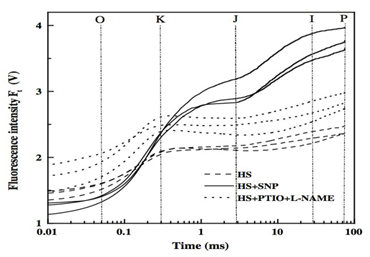Name:
Tell:
Email:
Organization:
NO Enhanced PSII Recovery Process of Tall Fescue under Heat Stress
2013-07-19
Temperatures above the normal optimum are sensed as heat stress in plants. As the global temperature rises, the impact of heat stress on plants growing becomes more and more significant. Tall fescue (Festuca arundinacea), as a major cool season forage and turf grass specie grown in the temperature regions of the world, is sensitive to the heat stress. Nitric oxide (NO) mediates plant responses to heat stress. Therefore, it is of great importance to study the role of NO in tall fescue in photosynthetic recovery process under heat stress.
In order to investigate the protective role of NO in the recovery process of photosystem II (PSII) in tall fescue against heat stress. Post doctor CHEN Ke under the supervision of Prof. FU Jinmin from Wuhan Botanical Garden (WBG) conducted the exogenous addition of NO donor and the NO scavenger along with synthesis inhibitor comparatively to study the role of NO in recovery process of tall fescue against heat stress. Chlorophyll a fluorescence measurements were employed to study both the effects of NO on the photosynthetic apparatus as well as the productivity of photosynthetic organisms.
Treatment of tall fescue leaves with NO donor sodium nitroprusside significantly improved the overall behavior of PSII probed by the chlorophyll a fluorescence transients, while the inhibition of NO accumulation by 2 - phenyl - 4, 4, 5, 5 - tetramethyl - imidazoline - 1 - oxyl - 3 - oxide (PTIO, a NO scavenger) plus NG - nitro - L- arginine - methyl ester (L- NAME, NO synthase inhibitor) dramatically disrupted the operation of PSII. Specifically, under heat stress, the exogenous NO reduced the initial fluorescence ( F0 ), increased the maximal quantum yield (FV / FM), and disappeared the K-step of 0.3 ms. By the analysis of the JIP-test, the exogenous NO improved the quantum yield of the electron transport flux from QA to QB (ET0 / ABS), and decreased the trapped excitation flux per reaction center (RC) (TR0 / RC), electron transport flux per RC (ET0 / RC), and electron flux reducing end electron acceptors per RC (RE0 / RC). In addition, the exogenous NO reduced the content of H2O2, O2• - , and malondialdehyde and electrolyte leakage of tall fescue leaves.
These data suggested that exogenous NO could protect plants, increase the amount of activated RC and improve the electron transport from oxygen evolving complex to D1 protein. Moreover, quantitative RT-PCR revealed that, in the presence of hydrogen peroxide, NO induced the gene expression of psbA, psbB, and psbC, which encoded proteins belonging to subunits of PSII core reaction center (Psb) complex.
These findings indicated that, as an important strategy to protect plants against heat stress, NO could improve the recovery process of PSII by the up regulation of the transcriptions of genes encoding PSII core proteins.
This research was supported by the National Natural Science Foundation of China, The National High Technology Research and Development Program of China and the Special Fund of Industrial (Agriculture) Research for Public Welfare of China. The study entitled “Alleviation of heat damage to photosystem II by nitric oxide in tall fescue” has been published online in Photosynthesis Research.

The effect of nitric oxide on OJIP fluorescence transients in tall fescue leaves under heat stress(Image by CHEN Ke )